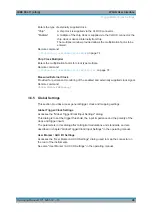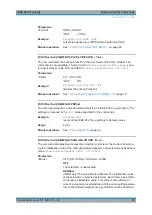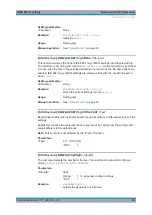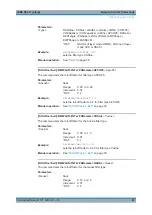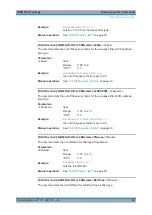
WLAN User Interface
IEEE 802.11 (a/b/g)
47
Operating Manual 1171.5283.12 ─ 18
3.6.4
Clock Settings
The clock settings is used to set the clock source and a delay if necessary.
Sync. Mode
(for R&S SMBV only)
Selects the synchronization mode.
This parameter is used to enable generation of precise synchronous signal of several
connected R&S SMBVs.
Note:
If several instruments are connected, the connecting cables from the master
instrument to the slave one and between each two consecutive slave instruments must
have the same length and type.
Avoid unnecessary cable length and branching points.
"None"
The instrument is working in stand-alone mode.
"Sync. Master" The instrument provides all connected instrument with its synchroni-
zation (including the trigger signal) and reference clock signal.
"Sync. Slave"
The instrument receives the synchronization and reference clock sig-
nal from another instrument working in a master mode.
Remote command:
[:SOURce<hw>]:BB:WLAN:CLOCk:SYNChronization:MODE
Set Synchronization Settings
(for R&S SMBV only)
Performs automatically adjustment of the instrument's settings required for the syn-
chronization mode, selected with the parameter "Synchronization Mode".
Remote command:
[:SOURce<hw>]:BB:WLAN:CLOCk:SYNChronization:EXECute
Clock Source
Selects the clock source.
"Internal"
The internal clock reference is used to generate the symbol clock.
"External"
The external clock reference is fed in as the symbol clock or multiple
thereof via the CLOCK connector.
The symbol rate must be correctly set to an accuracy of +/-2 % (see
data sheet).
The polarity of the clock input can be changed with the aid of "Global
Trigger/Clock Settings".
For two-path instruments this selection applies to path A.
Remote command:
[:SOURce<hw>]:BB:WLAN:CLOCk:SOURce
Clock Mode
(Clock source external only)
Trigger/Marker/Clock Settings
















